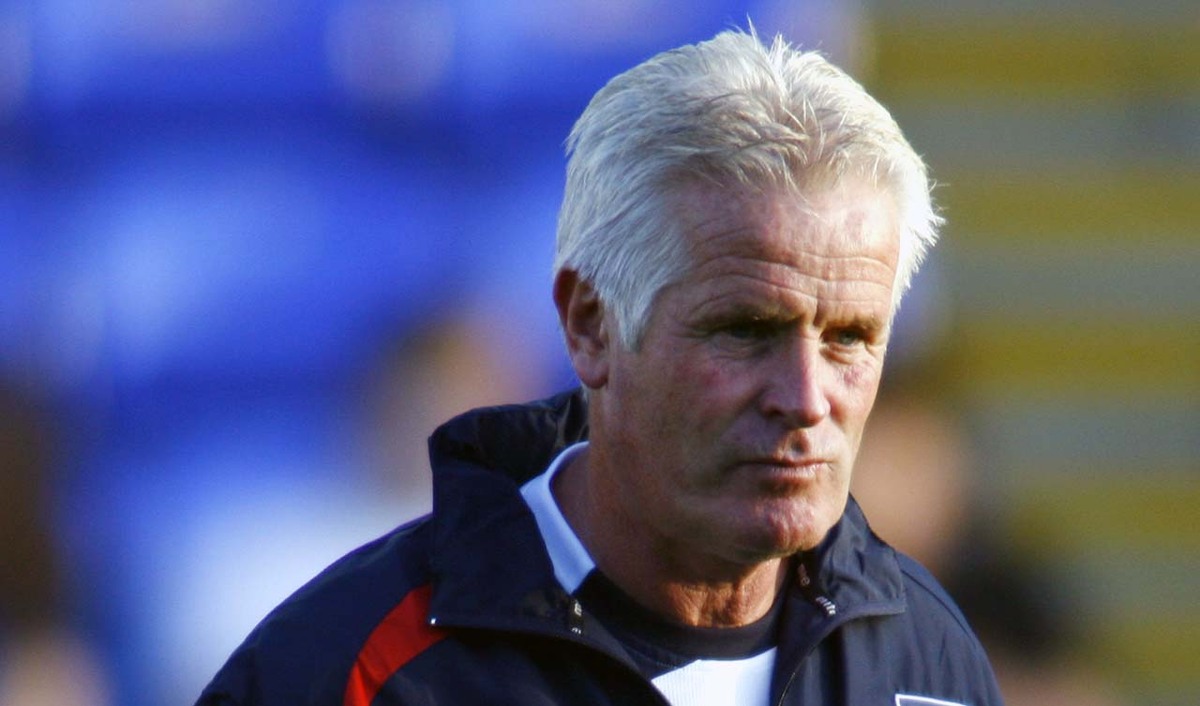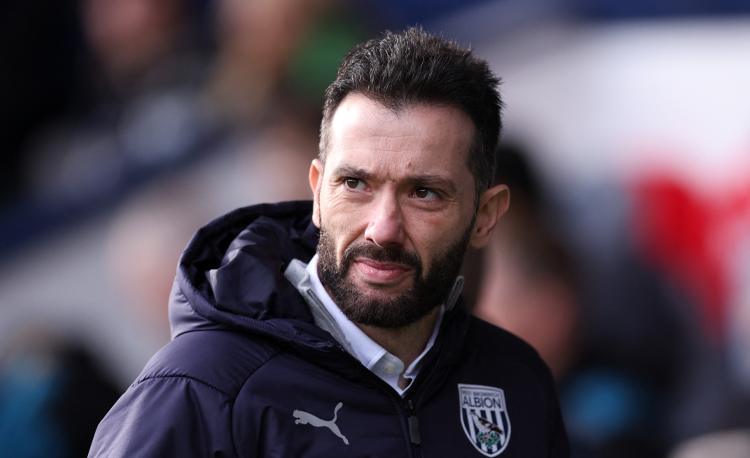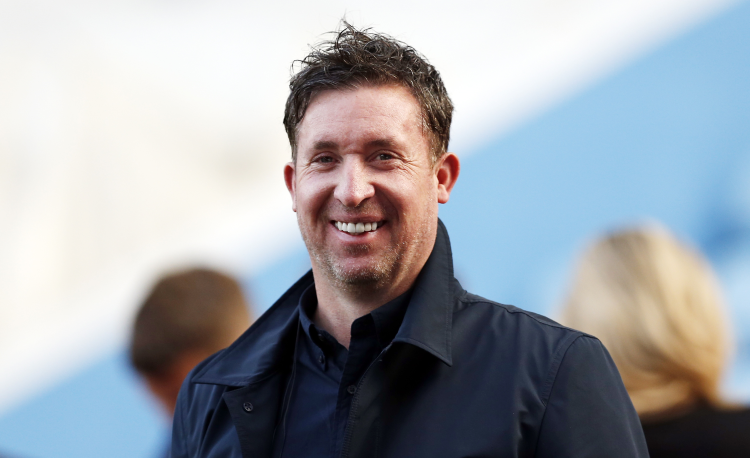You are viewing 1 of your 1 free articles
Keeping the ball to move forwards
This session is based around a series of possession-based practices that are aimed at breaking the lines to move forwards when possible. It involves lots of varied passing techniques and good decision making. It also begins with a warm-up that is relevant to the topic, one that will prepare the players for the activities that follow.
| Area | Up to two-thirds of pitch |
| Equipment | Balls, bibs, cones, poles, hurdles, ladder, mannequins, 1 full size goal |
| No. of Players | Up to 12 + 2 goalkeepers |
| Session Time |
Passing triangle: 15mins, Italian square: 20mins, Keep ball: 10mins, Breaking lines: 30mins |
This session is based around a series of possession-based practices that are aimed at breaking the lines to move forwards when possible. It involves lots of varied passing techniques and good decision making. It also begins with a warm-up that is relevant to the topic, one that will prepare the players for the activities that follow.
All the practices require players to be constantly on their toes, making decisions about what to do in tight areas of the pitch. It’s important to use practices like these to put pictures of how to play forwards in the players’ minds, as it helps to enhance their decision making, both on and off the ball. The session also focuses on the varied passing styles that are encountered during a game and it helps players to understand when and where a particular type of pass can be used to gain an advantage.
What do I get the players to do?
Passing triangle
For this warm-up routine, we set up a passing triangle with a row of poles on one side of the triangle, a ladder on the second side, and a row of hurdles on the final side. The size of the triangle can vary, depending on the length of passes to be practised. Here, we are using a passing triangle of 18x18x18 yards. We are using 9 players.
Three players start on each corner. The first player passes to the next point of the triangle and then follows the pass, joining the back of the queue of players at that corner. The player who receives the first pass immediately plays the ball to the next point and follows the pass. The routine continues around the triangle in the same manner.
We start the warm-up with this simple passing and running sequence, and when the players are used to it, we progress the activity by getting them to manoeuvre through the poles, the ladder and the hurdles while they are making their run, as shown [1]. They should do this with progressively tempo, make the practice more directional and specific to the players’ positions.We want players to use no more than two touches, receiving with the back foot and passing with the same foot. When needed, we rotate the play in the opposite direction.
1
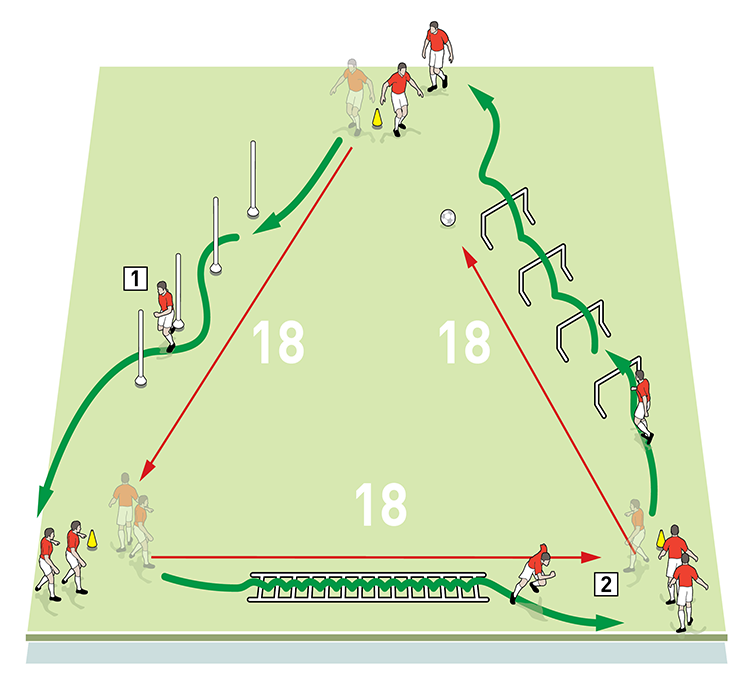
2. Get players to receive on their back foot and pass with their second touch using the same foot
What do I get the players to do next?
Italian square
We set up an area of 15x15 yards. We are using 8 players split into two teams of 4. Teams have a player at each end and 2 players in the middle of the area. Teams look to retain possession and move the ball from one end of the area to the other, as shown [2]. If a team wins the ball, they should keep hold of it and try to break the lines of the opposition to get it to one of their players on the outside.
2
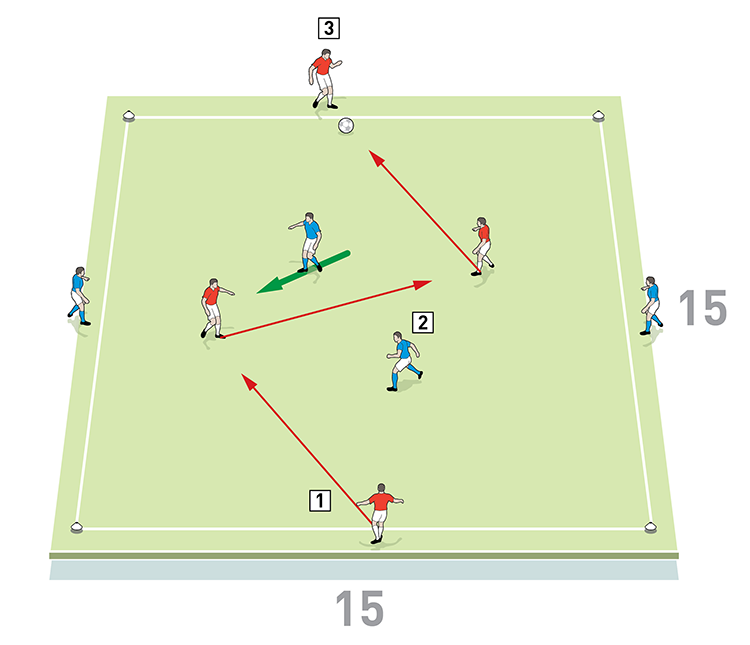
2. The blues press and if they win the ball, they should try to keep possession and work the ball to an end player
3. Eventually make the outside players one-touch to keep the ball moving at high tempo
When players get used to the activity, add in a challenge by making outside players one-touch. This will keep the ball moving at a high tempo. To test players further, reduce the size of the area to make it harder to keep possession.
Italian square progression
To progress the Italian Square, we now move the principles into a more realistic environment. We set up a larger area of 30x18 yards, split into two halves. We are using 10 players and 2 goalkeepers. We start with a winger on either side and we are using the goalkeepers (or we could use strikers) as target players at each end. The remaining 8 players are divided into two teams of 4, playing a 4v4 in one half, as shown [3]. The blue team in possession can use the help of the wingers and the target player in that half to create a 7v4 overload in their favour. They must make eight passes to score a point.
3
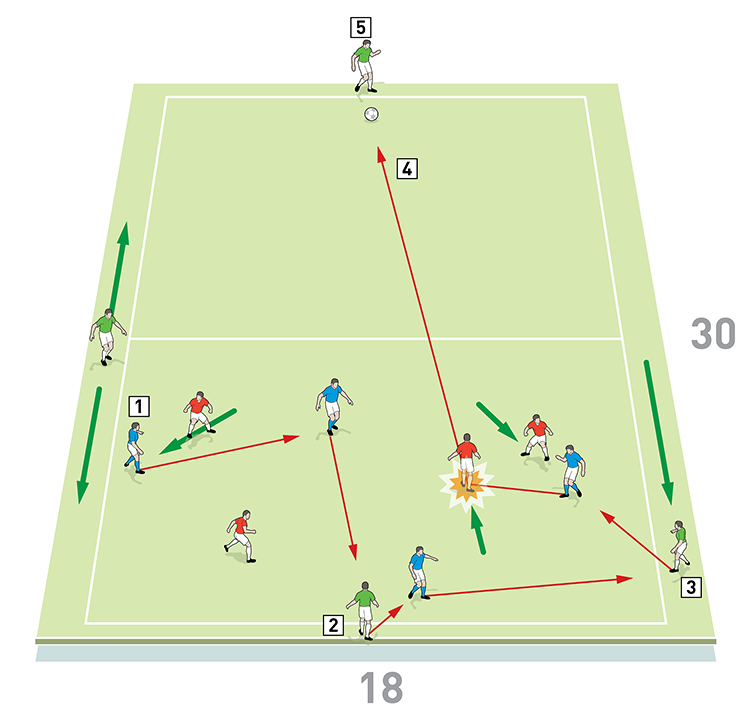
2. The possession team can use the target player at their end to help them keep the ball
3. The possession team can also use the wingers, giving them a 7v4 overload
4. If the reds win possession, they look to transfer the ball to the target player at the other end
5. When the target player receives the ball, both teams move into that half. The reds must then try to make eight passes to score
If the red opposition team wins the ball, they look to transfer to the target player in the opposite half as soon as possible. Both teams then move into that half and the new possession team tries to keep the ball and attempts to make eight passes to score a point.
Once everyone is doing what is required to a good standard and tempo, make the practice more directional and specific to the players’ positions. For instance, have a goalkeeper at one end and a striker at the other end. The blue team could be made up of two centre backs and two full backs, while the red team could be made up of midfielders and a second striker.
Keep ball
We set up an area of 22x18 yards. We’re using 12 players split into three teams of four, with one team of four pressing and the other two teams linking up to keep the ball, as shown [4a]. To start the team with all its players on the outside (the greens) must pass in to the team with two players in the middle (the blues) to replicate the ball being played through the middle of the pitch. The aim is for the two teams to link up to work the ball to the green players on the other side of the area.
4a
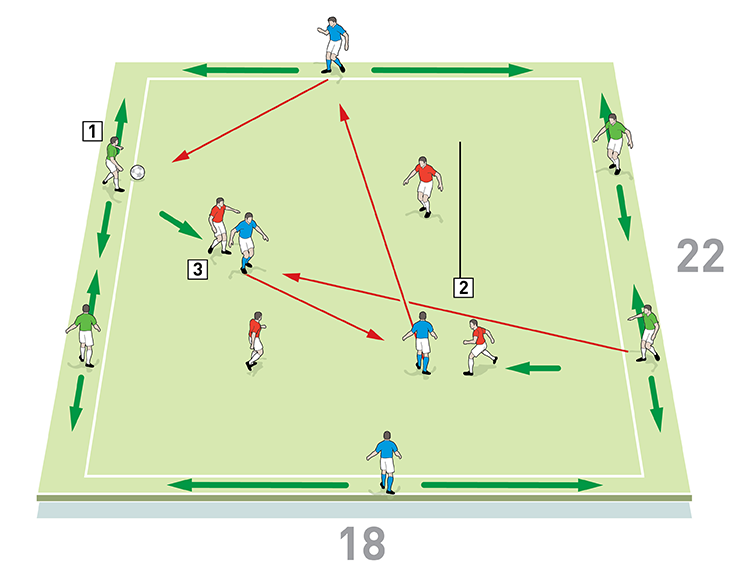
2. The ball is passed via the blues in the middle on its way to the other side
3. The reds should press and try to win the ball
If the red pressing team wins the ball, they try to keep possession by passing between the four of them, creating a 4v2 in the centre, as shown [4b]. No outside player can help to win the ball back. After six passes, an outside player from the team with the two players in the middle (the blues) can enter the area to make it 4v3. If the blues win the ball back, they continue with their objective to link up with the greens and play the ball from one side to the other. However, if the reds keep the ball for a further six passes in the 4v3, the last blue player on the outside can enter the pitch to create a 4v4.
4b
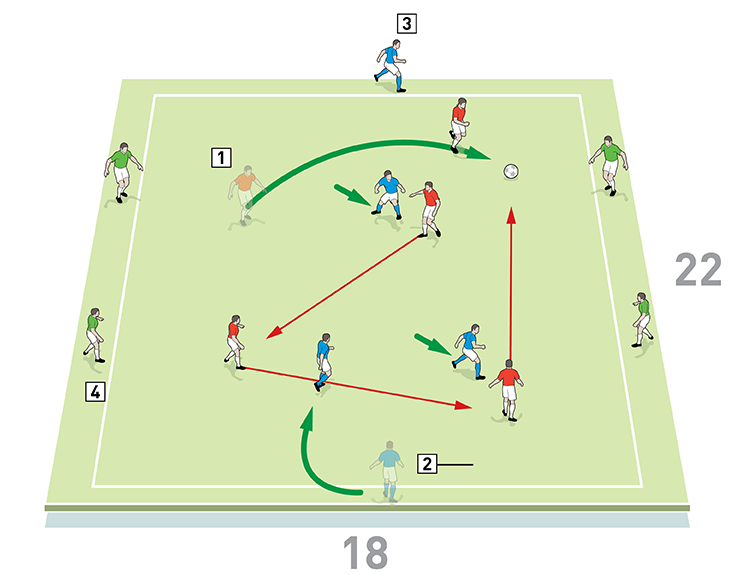
2. After the reds have made six passes, one of the outside blues can enter the area to help press
3. If the reds keep the ball for a further six passes in the 4v3, the last outside blue can enter the area to create a 4v4
4. If the blues win possession in the centre, the greens should be ready to play a part in transferring the ball from side to side again
Now the remaining four players on the outside (the greens) must be alert to the ball being won back by the blues and ready to counter-attack by playing the ball to the other side, via the blues in the centre.
How would I put this into a game situation?
Breaking lines
We set up on two-thirds of a pitch with four mannequins placed 10 yards apart on the line of the final third. The mannequins represent defenders. A team of 4 red midfielders starts in front of the mannequins. The reds protect a goal and a goalkeeper, while the 4 blues attack the goal with the help of 2 wide players who work up and down the touchline. The blues also have a goalkeeper (or a server) who starts play and who can recycle the ball if necessary, but coaches should encourage forward play when possible.
The blues begin with the ball and their keeper serves to a team mate to start. The attackers must combine and break the lines of the red midfielders and the mannequins to try to slide a ball through for a 1v1 against the keeper, as shown [5]. The mannequins represent the offside line and only the attacker can go into the final third for the 1v1.
5
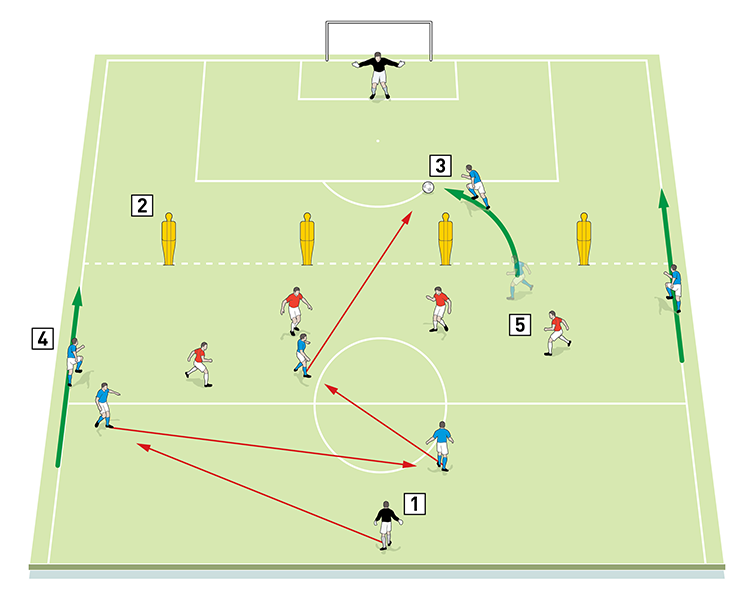
2. The line of mannequins represents opposition defenders and also serves as the offside line
3. The blues aim to break the lines of the red midfielders and mannequins. They must slide a ball through for a 1v1 against the keeper. Only the attacker can go past the mannequins
4. The wingers work on the touchline and can be used to give the blues an attacking overload
5. If the reds win possession they must play the ball to the opposition keeper. Then they must regroup quickly as the blues can begin another attack
If the red defending team wins the ball back, they must try to break the lines of the attackers and pass through to the opposition keeper to score a point. The cycle then starts again with a serve from the keeper to the blue attackers. The reds must retreat quickly and regroup to stop the blues from getting into the final third.
What are the typical mistakes that players might make, and how do I avoid them?
Typical mistakes are mainly based around decision making and the speed at which decisions are made. Mistakes happen in these practices because players don’t think quickly enough.
If a player is getting closed down when receiving the ball, then before it arrives they need know where the ball is coming to them from and how it is coming, plus where their team mates and opponents are, so they can decide what to do with the ball.
If a player has time on the ball, they can wait for the right moment before deciding on the correct options, but this depends on the position of their team mates and their opponents. The point is not to have the players playing at a high tempo and with one touch all the time, but to teach them to be aware of the options before they receive the ball. This will help them to make the right decisions.
Related Files
Editor's Picks
Using the goalkeeper in build-up play
Pressing principles
Intensive boxes drill with goals
Penetrating the final third
Creating and finishing
My philosophy
Pressing initiation
Compact team movement
Defensive organisation
Coaches' Testimonials

Alan Pardew

Arsène Wenger

Brendan Rodgers

Carlos Carvalhal

José Mourinho

Jürgen Klopp

Pep Guardiola

Roy Hodgson

Sir Alex Ferguson

Steven Gerrard
Related
Coaches' Testimonials

Gerald Kearney, Downtown Las Vegas Soccer Club

Paul Butler, Florida, USA

Rick Shields, Springboro, USA

Tony Green, Pierrefonds Titans, Quebec, Canada
Join the world's leading coaches and managers and discover for yourself one of the best kept secrets in coaching. No other training tool on the planet is written or read by the calibre of names you’ll find in Elite Soccer.
In a recent survey 92% of subscribers said Elite Soccer makes them more confident, 89% said it makes them a more effective coach and 91% said it makes them more inspired.
Get Monthly Inspiration
All the latest techniques and approaches
Since 2010 Elite Soccer has given subscribers exclusive insight into the training ground practices of the world’s best coaches. Published in partnership with the League Managers Association we have unparalleled access to the leading lights in the English leagues, as well as a host of international managers.
Elite Soccer exclusively features sessions written by the coaches themselves. There are no observed sessions and no sessions “in the style of”, just first-hand advice delivered direct to you from the coach.
